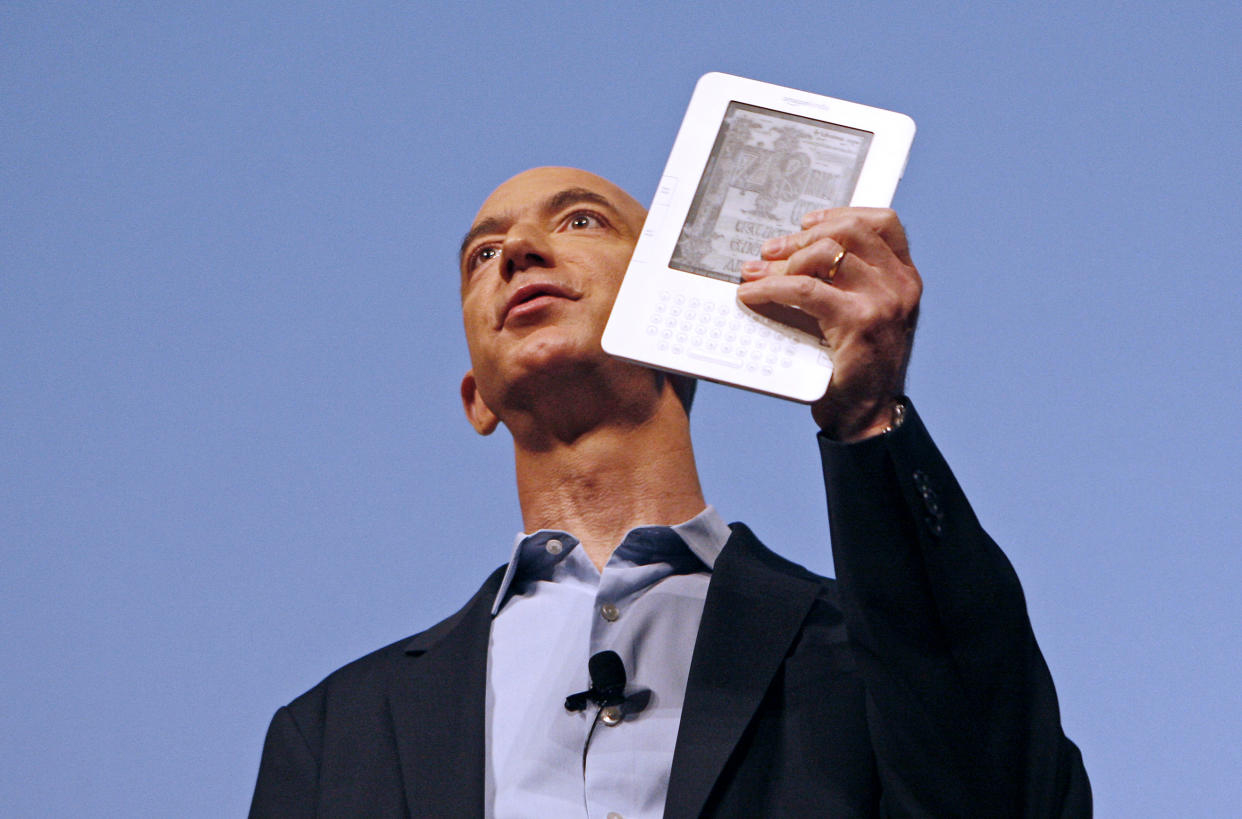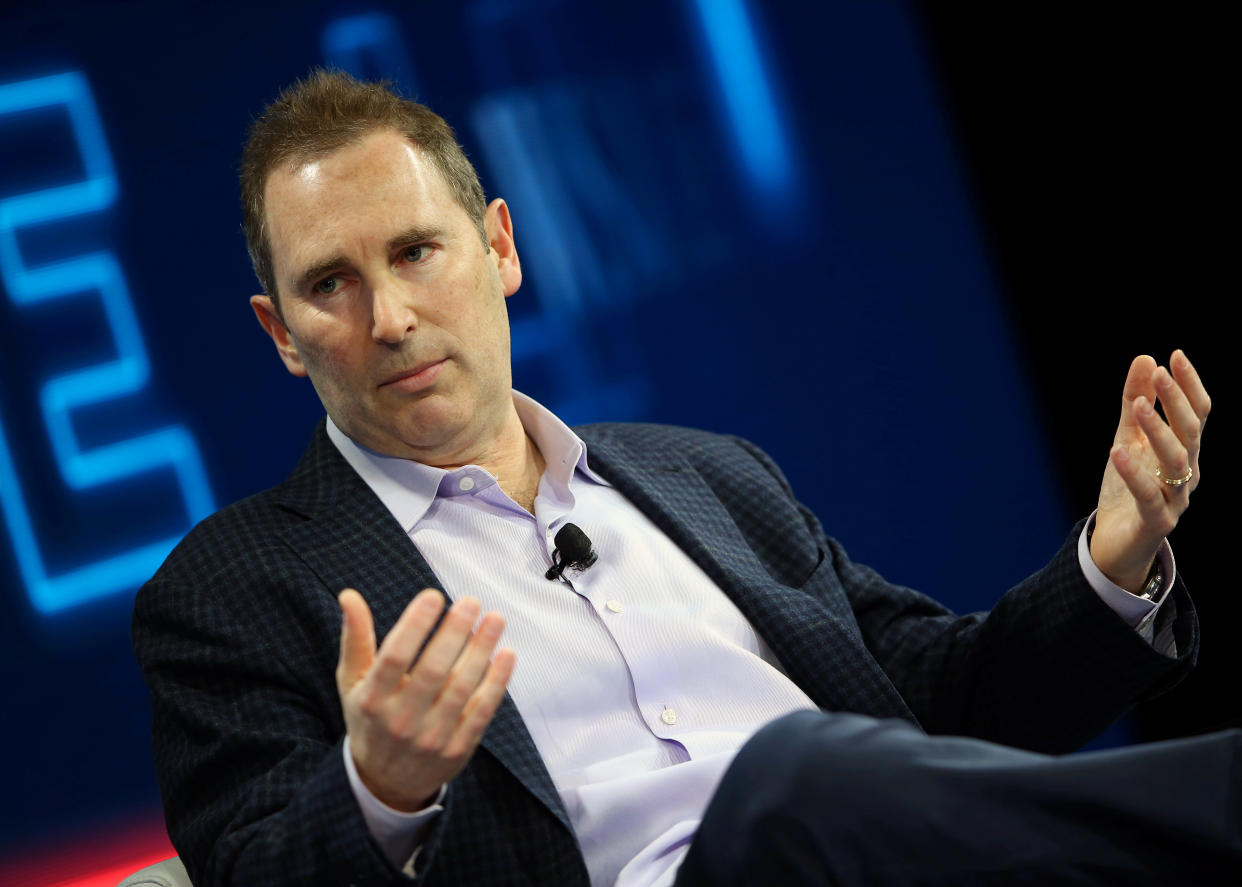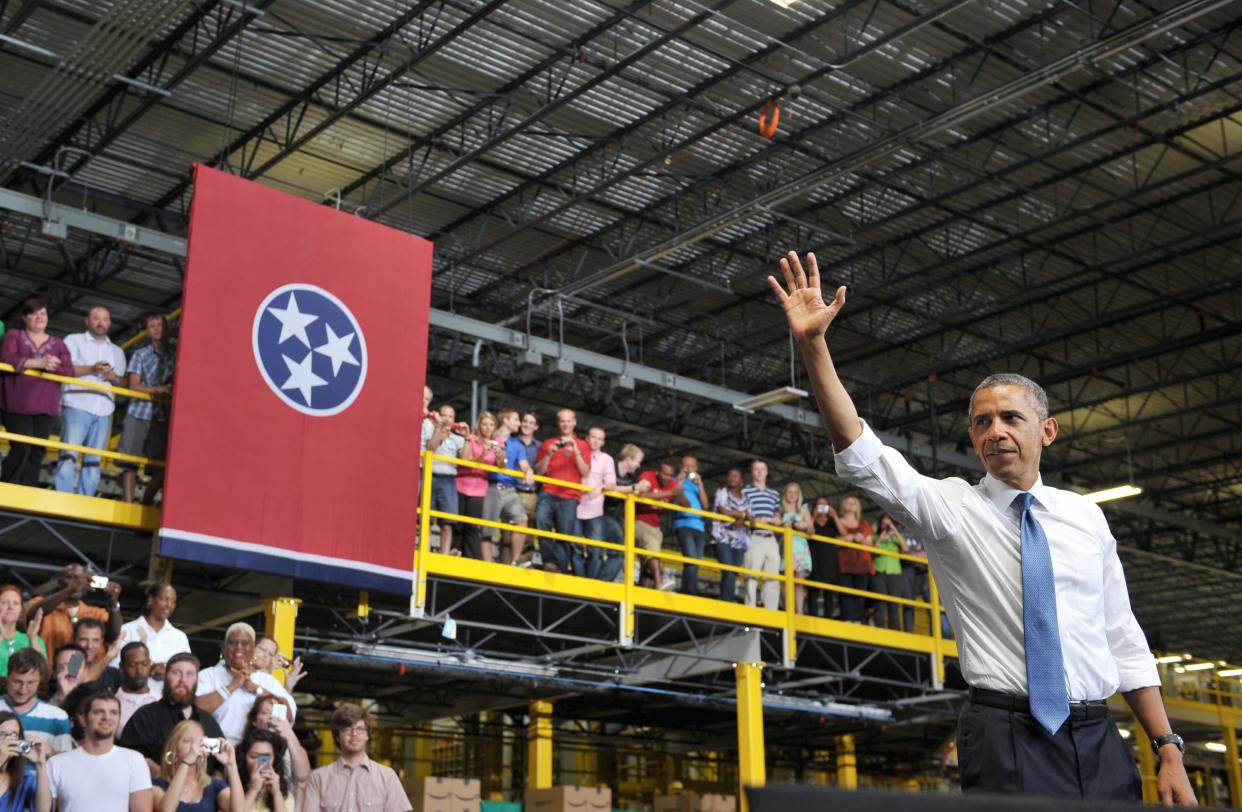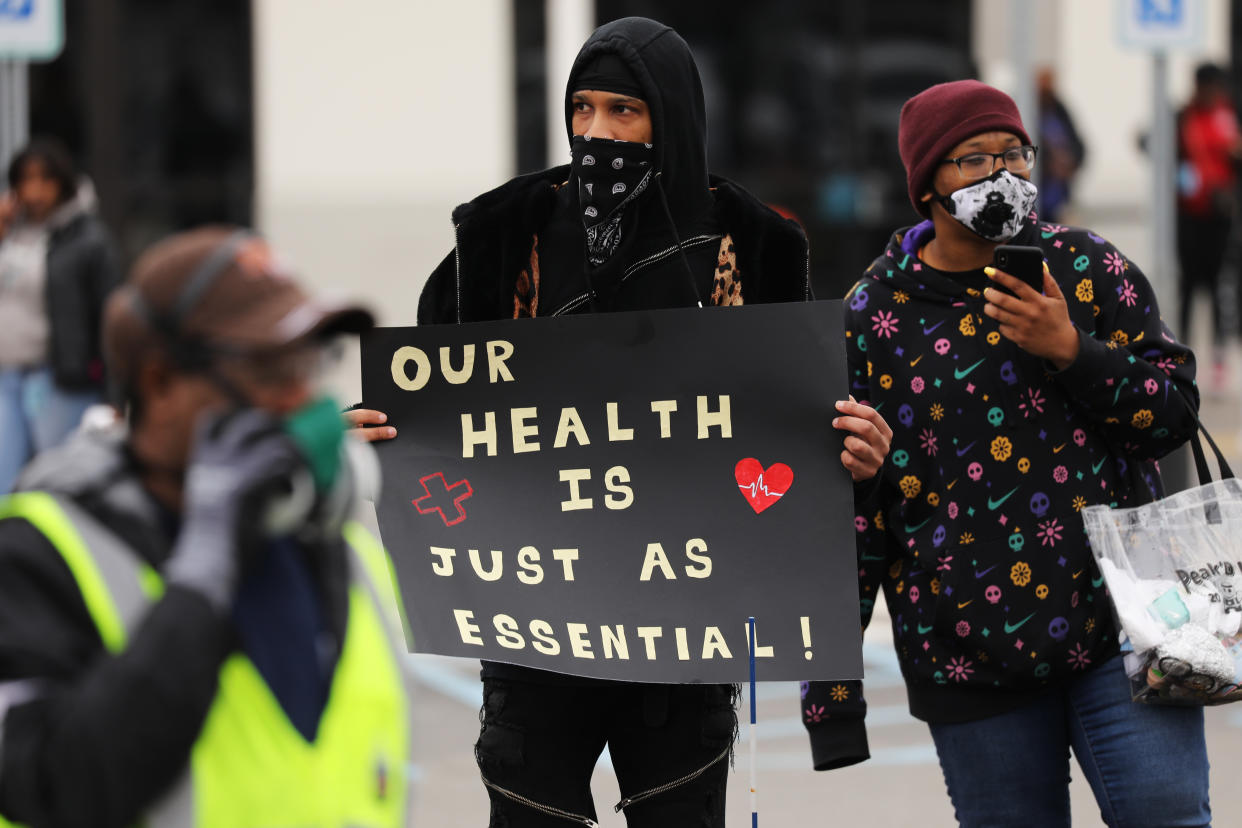Jeff Bezos made Amazon a behemoth, but his legacy is complicated
On July 5, Jeff Bezos will officially step down as CEO of the company he founded in 1994. Amazon (AMZN) will continue to exist, of course: It’s one of the most highly valued publicly traded companies in the world with a market capitalization of $1.7 trillion. But Bezos’ decision to leave the post, nevertheless, marks a new era for the e-commerce giant.
The richest person on Earth, Bezos kick started the e-commerce revolution, forcing rivals like Walmart (WMT) to jump into the arena or be left in the dust. The company’s Amazon Web Services platform, meanwhile, essentially launched the public cloud movement. But Bezos, who will remain as chairman of Amazon’s board while he devotes more time to other ventures like his space firm Blue Origins, isn’t without controversy.
Amazon’s treatment of workers in particular has drawn the ire of elected officials and labor advocates, and the company is in the crosshairs of antitrust regulators seeking to change its business practices. Still, Bezos’ impact on the business world can’t be overstated.
“He's led Amazon to be one of the most successful if not the most successful company ever in the history of public markets,” Forrester vice president and principal analyst Sucharita Kodali told Yahoo Finance. “That is very much tied to him and his leadership skills.”
From bookstore to ‘Everything Store’
Amazon wasn’t always the “Everything Store” as author Brad Stone called it in his book, “The Everything Store: Jeff Bezos and the Age of Amazon.” The company started as an online bookstore. As Amazon grew, however, the company began to spread its tendrils into different retail offerings. From there, it quickly exploded in popularity.
That started with the sale of music and movies, which led to sporting goods, home improvement items, and eventually the introduction of third-party sellers. As Amazon’s sales increased, competitors began piling into e-commerce, creating an entirely new industry.
“He single-handedly drove the success of much of the e-commerce industry,” Kodali said. “I think that he did a lot of things that other companies would not have had the audacity to do, and that led to a lot of consumers adopting the channel and a lot of competitors trying to do everything they could to keep up with Amazon.”

In 2005, Amazon launched its successful Prime service, which now gives subscribers access to free two-day delivery, and perks ranging from access to Amazon Prime Video and Prime Music.
Amazon plays its number of Prime subscribers relatively close to the chest, but in April, Bezos revealed, as part of his final annual shareholder letter as CEO, that the company had reached a whopping 200 million Prime members.
That kind of growth has blown away analysts like Kodali, who says it’s nearly unheard of to see a business expand by such leaps and bounds.
“He has grown the business at extraordinary levels which I don't completely understand and I don't know that the world completely understands, because it truly is baffling the sheer volume that it grows every year,” she said. “It's almost incomprehensible.”
Selling on the web to power it
Bezos’ pitch to sell books online was still a new idea when he founded Amazon in 1994, not long after the dawn of the internet itself. The company expanded beyond books four years later, but it did not post a profit until the last quarter of 2002.
The business that would launch Amazon’s profits into the stratosphere was its Amazon Web Services (AWS). Launched in 2006, the commercial cloud platform gives third-party companies access to the computing power and resources needed to run their online businesses without dumping money into their own hardware. And it’s been a cash cow for Amazon.
In 2019, the business raked in $35.03 billion, growing to $45.37 billion in 2020, a 30% year-over-year increase. Amazon only began breaking out AWS revenue in 2015, at which point the business accounted for $5 billion in annual revenue. AWS is also more profitable than the core Amazon business, with the cloud platform bringing in $13.53 billion in net income in 2020 compared to the e-commerce side’s $9.36 billion.
Since the launch of AWS, cloud computing has become a massive business for tech firms including Microsoft (MSFT) and Google (GOOG, GOOGL). But according to Canalys, Amazon still holds the largest chunk of the global cloud market share with 32%. Microsoft is its closest competitor with 19% of global market share, and Google is a distant third at 7%.

As proof that Bezos’ bet on AWS has paid off, Amazon has named AWS CEO Andy Jassy as Bezos’ successor as CEO of the entire firm.
“He basically put the lieutenant who is in charge of one of the most successful divisions of the company in charge of the company,” Kodali said. “This is somebody who's been at the company for a long time so it's not like you're handing the reins over to [a] clueless person.”
Bezos and the labor movement
Of course, no discussion of Bezos and his legacy at Amazon is complete without the company’s complicated labor relations history.
Amazon’s staggering growth over nearly three decades transformed the company from an 11-person startup to the nation’s second-largest employer, with roughly 1.3 million employees spread across a vast network of offices and warehouses.
That ever-expanding workforce has drawn admirers and critics of the influential management model popularized by Bezos, which features grueling performance quotas, analytics-driven supervision and evaluation, and staunch opposition to unionization.
The model optimizes efficiency and customer service, fueling profits and reinvestment that have created a wave of warehouse and delivery jobs in some of the nation’s most depressed regions. But the model also relies on taxing jobs that carry heightened rates of injury and turnover relative to Amazon’s peers, in turn diminishing industry standards and spurring widespread backlash, management experts, labor scholars, and worker advocates told Yahoo Finance.
“Bezos has had an impact on work and workers in the United States that can be matched by few people in the past half century,” says Joseph McCartin, an author and professor of labor at Georgetown University. “It’s an enormous impact, but it’s not all to the good.”
As Amazon grew, from the 1990s onward, towns and cities across the U.S. vied to be the home of one of its warehouse facilities, which often promised an infusion of thousands of jobs.
In 2007, Amazon operated just 18 warehouses across the U.S., including fulfillment centers, sortation centers, and miniature fulfillment centers called Prime Hubs, according to logistics consulting firm MWPVL International. Today, the company counts 381 such U.S. facilities, the MWPVL International says.
“It has been a huge deal for any city if it can get an Amazon fulfillment center,” says Dale Rogers, a professor of logistics and supply chain management at Arizona State University.

Cities have backed up their pursuit of Amazon with money. Enthusiasm from state and local officials has manifested in numerous public subsidies paid to lure the company and its jobs, though a 2018 study from the left-leaning Economic Policy Institute found that an Amazon warehouse doesn’t result in overall job gains for the local community, since the Amazon positions are likely offset by job losses elsewhere.
In the aftermath of the Great Recession, President Barack Obama joined the chorus of public officials who praised the company as an engine of the nation’s economic recovery. At a warehouse in Chattanooga, Tennessee, in 2013, he addressed hundreds of employees. “Amazon is a great example of what’s possible,” he said. “I look at this amazing facility and you guys, you don’t miss a beat.”
Worker testimony about the conditions at the warehouses had already revealed a less glamorous reality. In 2011, an article in “The Morning Call,” a local newspaper in Allentown, Pennsylvania, cited accounts of unbearable heat, near-impossible production demands, and the frequent use of temp work at a nearby Amazon facility.
In the ensuing years, warehouse workers and delivery drivers have said that demanding quotas and digital surveillance penalize them for taking breaks and put them at risk of injury — or termination if they can’t keep up. An investigation released by Reveal and the Seattle Times in September found that Amazon warehouse workers sustain injuries at rates more than double the industry average.
“Jeff Bezos and his enormous senior teams have proven there are opportunities for extreme efficiency that come with mastering the technologies on pricing, delivery, warehousing, and supply chains,” says Michael Useem, a professor emeritus at the Wharton School of Business.
“But using tools of people analytics to optimize how people get work done sometimes brings enormous cost and downside to the people involved,” he adds.
Over the years, labor advocates have also taken issue with the wages and anti-union posture at Amazon. The Fight for $15, launched in 2012, sought a $15 wage floor in the fast food industry, but it also directed the ire of the labor movement at companies like Amazon. Meanwhile, the e-commerce giant began to face attacks from progressive Senator Bernie Sanders (I-VT), who in 2018 introduced the Stop BEZOS Act, which sought to pressure large companies to raise wages by taxing them if their workers needed to use subsidy programs like food stamps.
Amazon instituted a $15 wage floor later in 2018, eliciting praise from Sanders. Furthermore, in January, Amazon backed legislation that would gradually raise the federal minimum wage from $7.25 to $15 per hour. In May, the company announced it would hire 75,000 workers at an average starting wage of over $17 per hour.
Months after Amazon instituted its $15 minimum wage, in 2019, the company abandoned an effort to locate a second company headquarters in Queens, New York. The company’s unwillingness to promise neutrality toward a then-ongoing union drive at its Staten Island warehouse became a lightning rod for critics, and contributed to the failure of the plan.

But ultimately, the labor legacy of Bezos may center on his final chapter with the company, which coincided with a sales boom and worker protests prompted by the COVID-19 pandemic.
The novel coronavirus fueled record e-commerce revenue for Amazon as hundreds of millions of Americans were forced into their homes, prompting the hiring of hundreds of thousands of workers and plans to expand its warehouse network. But it also elicited a new set of grievances asserting that the pandemic created health risks and workers weren’t compensated appropriately.
Last year, Amazon told Yahoo Finance that "nothing is more important than the health and safety of our employees." Indeed, following the pandemic, Amazon made efforts to take the temperature of workers before they entered U.S. facilities, provide all workers with protective masks, and give partial pay to workers who were sent home with a fever.
Still, the worker backlash culminated with a high-profile, months-long labor battle at the company’s warehouse in Bessemer, Alabama earlier this year. Amazon made its anti-union position known in an aggressive campaign carried out through multiple avenues, including mandatory meetings and a website that warned of onerous dues payments.
In a sign of how public sentiment toward Amazon and Bezos had shifted, President Joe Biden released a video in early March defending the right of workers to unionize and made reference to "workers in Alabama" without mentioning Amazon, widely perceived as an allusion to the labor battle at the tech giant.
In the end, workers voted overwhelmingly against the union, though a decision is pending from the National Labor Relations Board over claims that Amazon illegally interfered with the organizing campaign.
"It’s easy to predict the union will say that Amazon won this election because we intimidated employees, but that’s not true," the company said in a statement following the vote. "Our employees heard far more anti-Amazon messages from the union, policymakers, and media outlets than they heard from us. And Amazon didn’t win — our employees made the choice to vote against joining a union."
In a shareholder letter released after the vote, Bezos acknowledged the need to improve treatment of employees at the company.
“I think we need to do a better job for our employees," Bezos wrote in the letter, the last of his tenure as CEO. "While the voting results were lopsided and our direct relationship with employees is strong, it’s clear to me that we need a better vision for how we create value for employees — a vision for their success."
Similarly, the company pledged support for its workers and vowed to improve.
"Our employees are the heart and soul of Amazon, and we’ve always worked hard to listen to them, take their feedback, make continuous improvements, and invest heavily to offer great pay and benefits in a safe and inclusive workplace," Amazon said following the vote. "We’re not perfect, but we’re proud of our team and what we offer, and will keep working to get better every day."
Stuart Appelbaum, president of the Retail, Wholesale, Department Store Union, which organized the union drive, offered a different interpretation of the election.
“The election in Bessemer was a public relations disaster for Bezos and Amazon,” Appelbaum says. “He created a model for work that is something that every American needs to be concerned about, where humanity isn’t respected.”
The labor movement has redoubled its efforts to unionize Amazon. Last week, days before Bezos steps down as CEO, the well-funded International Brotherhood of Teamsters launched an ambitious nationwide campaign to unionize the company.
“His legacy will be one of lowering standards, not raising them,” says Iain Gold, director of strategic research and campaigns with the Teamsters.
“It’s unfortunate for a guy that’s created a massive company and done lots of innovation,” Gold adds. “I would hope the legacy would be more of where he innovated labor relations — broke the mold of the U.S. where it’s such an adversarial labor-management relationship."
Labor scholars and advocates said they expect a similar management approach from the incoming CEO, Jassy, since he has spent a long career as an executive at the company. But they also believe Bezos, in his new role as executive chairman, will continue to shape working conditions at Amazon and in the economy at large.
“Will it be any different? You always hope,” says Randy Korgan, the Teamsters’ National Amazon Director. But, he adds, “We’re not fools.”
Dan Howley is the tech editor at Yahoo Finance. Find him on twitter@DanielHowley.
Max Zahn is a reporter for Yahoo Finance. Find him on twitter @MaxZahn_.
Read more:
Amazon’s breakup faces ‘long odds,’ says 'Amazon Unbound' author Brad Stone
Amazon defeats union in Alabama warehouse, union claims illegal interference
Amazon critic Lina Khan will be 'aggressive' in taking on Big Tech at FTC, lawmaker says
Why the Teamsters union drive at Amazon could succeed where Bessemer faltered
